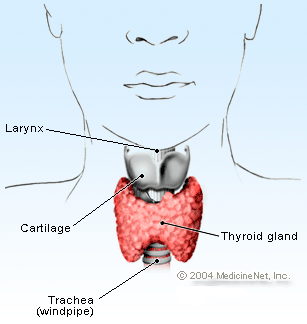Thyroid Disorders Symptoms and Signs
- What Is It?
- Thyroid Gland Pictures
- Thyroid Disorder Symptoms/Signs
- 12 Hyperthyroidism Symptoms
- 15 Hypothyroidism Symptoms
- 3 Thyroid Nodule Symptoms
- Do I Have Thyroid Problem?
What is thyroid disease?

Hyperthyroidism or overactive thyroid can be caused by a condition known as Graves’ disease, inflammation of the thyroid gland (known as thyroiditis), or by tumors that secrete thyroid hormones.
Thyroid disease is common. Thyroid disease can result from conditions that cause over-or under-function of the thyroid gland.
- When the gland produces too much thyroid hormone, the condition is known as hyperthyroidism.
- When the gland does not function sufficiently, there is too little thyroid hormone produced (hypothyroidism).
- In addition to problems with the level of hormones made by the gland, both benign and malignant tumors (cancers) can cause enlargement of the thyroid gland or nodules (lumps) within the gland.
- Enlargement of the thyroid gland in the neck can cause symptoms that are directly related to the increase in the size of the organ (such as difficulty swallowing and discomfort in front of the neck).
What is the thyroid gland? Where is it located and what does it look like?

The thyroid gland is a metabolism hormone-producing gland in the lower part of the neck, below Adam's apple. It has two lobes attached to one another by a middle part called the isthmus and is located in front of the trachea. The thyroid produces essential hormones required by the body that help regulate metabolism, heart rate, blood pressure, and temperature. Thyroid hormones are also necessary for children to grow and develop.
Thyroxine (T4) and triiodothyronine (T3) are the two most important hormones made by the thyroid. The gland also makes calcitonin, a hormone involved in calcium metabolism. A hormone made by the pituitary gland called thyroid-stimulating hormone (TSH) acts to stimulate hormone production by the thyroid gland.
The thyroid gland is located below Adam's apple wrapped around the trachea (windpipe), and it has a butterfly shape. A thin area of tissue in the gland's middle, known as the isthmus, joins the two thyroid lobes on each side. The thyroid uses iodine to produce vital hormones. Thyroxine, also known as T4, is the primary hormone produced by the gland. After delivery via the bloodstream to the body's tissues, a small portion of the T4 released from the gland is converted to triiodothyronine (T3), which is the most active hormone.
What are the symptoms and signs of the different types of thyroid problems?

Just as the types of thyroid conditions can vary (for example, hypothyroidism, hyperthyroidism, Hashimoto’s thyroiditis, goiters, Grave’s disease, and cancer), so can the symptoms and signs of each thyroid problem.
12 Hyperthyroidism symptoms and signs (Graves' disease, thyroiditis, tumors)
Hyperthyroidism or overactive thyroid can be caused by a condition known as Graves’ disease, inflammation of the thyroid gland (known as thyroiditis), or by tumors that secrete thyroid hormones.
Symptoms and signs of hyperthyroidism
- Nervousness, tremor, agitation
- Irritability
- Poor concentration
- Reduced menstrual blood flow in women
- Racing heartbeat or palpitations
- Heat intolerance
- Changes in bowel habits, such as more frequent bowel movements
- Enlargement of the thyroid gland
- Skin thinning
- Brittle hair
- Increase in appetite, feeling hungry
- Sweating
15 Hypothyroidism symptoms and signs (Hashimoto's disease, cancer treatment side effects)

Inadequate functioning of the thyroid gland produces too little thyroid hormone (hypothyroidism). An autoimmune condition known as Hashimoto’s disease or Hashimoto’s thyroiditis is a common cause of hypothyroidism. Other causes can include the use of certain medications, side effects of treatments for thyroid cancer or hyperthyroidism, or radiation therapy to the head and neck.
Symptoms and signs of hypothyroidism
- Mental fogginess or sluggishness
- Depressed mood
- Excessive or prolonged menstrual bleeding
- Fluid retention, feeling bloated, puffiness in the face
- Joint aches and pains
- Weight gain
- High cholesterol levels
- Feeling cold, or increased sensitivity to cold temperatures
- Hoarseness
- Dry skin
- Constipation
- Fatigue
- Memory problems
- Thinning hair or hair loss
- Slowed heart rate
3 Thyroid nodule or cancer symptoms and signs
Nodules or lumps in the thyroid gland are benign (non-cancerous) in over 90% of cases. Thyroid nodules can form because of some of the conditions listed previously and lead to hyper- or hypothyroidism, for example:
- Hashimoto’s thyroiditis
- Iodine deficiency can also cause enlargement of the thyroid gland and thyroid nodules, now rare in the United States.
- Cysts in the thyroid gland can also cause lumps or nodules. A small number of thyroid nodules are the result of thyroid cancer.
- Most thyroid nodules do not cause symptoms, and most do not produce thyroid hormone. Sometimes, nodules actively produce hormones and can cause the symptoms of hyperthyroidism described previously.
- Difficulty swallowing
- Shortness of breath, due to compression of the airways
- A visible swelling or lump in the neck
What should you do if you think you have signs and symptoms of a thyroid disorder? Which type of doctors treat thyroid problems?
- Thyroid disease is a broad spectrum of disorders that may or may not lead to enlargement of the thyroid gland itself or the presence of lumps or nodules.
- Signs and symptoms of thyroid disease are apparent when the gland is over- or under-producing thyroid hormone.
- It is important to remember that none of these symptoms described in this article is specific for thyroid disease.
- A number of different conditions and normal states may cause all of them.
- Your doctor or endocrinologist (a doctor that specializes in thyroid problems and other endocrine problems) can order laboratory tests to evaluate the function of your thyroid gland if you have troubling symptoms.

